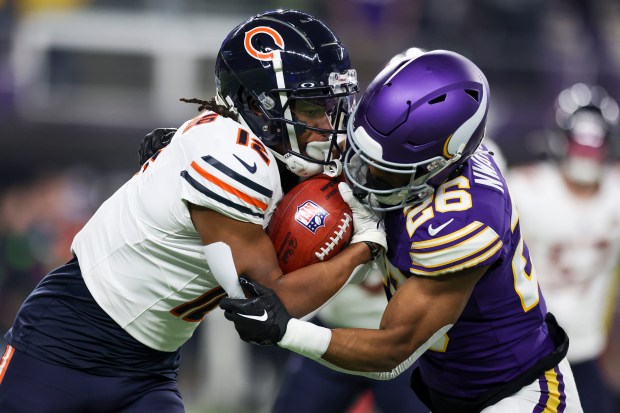
Chicago Bears Cut Velus Jones Jr.: A Symptom of Larger Issues with the Franchise’s Draft Strategy?
The Chicago Bears have officially released Velus Jones Jr., the 2022 third-round pick whose brief tenure with the team has left fans and analysts questioning whether the organization is capable of leveraging its draft capital effectively. Once touted as a playmaker who could bring speed, special teams expertise, and versatility to a struggling Bears offense, Jones’ departure may signify more than just a failed experiment—it exposes a pattern of misjudgment and questionable draft strategy that has become all too familiar at Halas Hall.
The Draft Investment That Never Paid Off
Velus Jones Jr. was drafted 71st overall in 2022, with the Bears banking on his unique skill set to add depth to a wide receiver room that has been notoriously underwhelming. Jones came out of college with a reputation as a dynamic return specialist and a potential deep-threat receiver, but the decision to draft him in the third round puzzled many fans and analysts. Why? Jones was 25 at the time—a notably older rookie for the NFL—and despite his speed, he lacked the polished route-running and hands that typically translate well into the league.
Even more concerning, Jones was immediately slotted into a depth chart that seemed devoid of a clear developmental plan for him. In his two seasons with the Bears, Jones struggled with drops, fumbles, and mental errors, leaving fans frustrated and coaches scrambling to find ways to use him effectively. His return game, once seen as his ticket to staying on the roster, also became shaky, with fumbles and muffed punts adding insult to injury. The Bears hoped he’d grow into a core special teamer and offensive weapon, but that hope never materialized.
A Sign of Draft Strategy Flaws?
The decision to cut Jones this early in his career brings up a bigger question: What does this say about the Bears’ draft strategy? Critics argue that this move speaks to a broader issue within the organization’s evaluation and development processes. Jones is just one of several recent mid-round picks who have failed to meet expectations in Chicago, reflecting a disturbing trend of wasted draft capital.
Fans are justified in wondering why the Bears reached for a player with glaring developmental needs and an unusual age profile in the third round. When players like Jones fail to pan out, it not only hurts the team’s immediate depth but also leaves long-term gaps that force the team to constantly chase after “the next guy,” instead of building a roster with stability and depth.
Some argue the Bears would have been wiser to select a younger prospect with a higher ceiling. Yet the organization has seemingly become enamored with players who might fill immediate needs rather than pursuing long-term developmental projects—a strategy that rarely yields sustained success in today’s NFL.
A Wake-Up Call for Bears Management?
Bears GM Ryan Poles and his staff are likely feeling the heat from fans and the media as this cut puts a glaring spotlight on the team’s roster-building issues. Drafting a player like Jones was always going to be a gamble, but the risk feels even more perplexing given how quickly the team has given up on him. When you consider the fact that Jones could have contributed as a role player or special teams asset, his release begins to feel more like an admission of failure from the front office than an indictment of Jones himself.
There are those who will argue that Poles deserves more time to implement his vision for the team. After all, he inherited a depleted roster and was tasked with overhauling a franchise that has been in a rebuilding cycle for years. But Jones’ release doesn’t bode well for Poles’ supposed vision. If the front office can’t accurately project which players fit their system and develop talent accordingly, why should fans expect future draft picks to fare any better?
The Cost of Repeated Mistakes
For the Bears, every draft pick is valuable currency, especially given the team’s struggles to field a competitive roster. Misses like Jones only make it harder for the organization to build depth and consistency, leading to a revolving door of players who never manage to stick around long enough to make a lasting impact. It’s a cycle that has left the Bears mired in mediocrity, and Jones’ release is just the latest chapter in a saga of questionable draft decisions.
The release of Velus Jones Jr. serves as a glaring reminder that the Bears must reassess their approach to the draft. If Chicago wants to escape this rut, the front office needs to put an end to the pattern of investing in players who are never fully developed or utilized.
Where Do the Bears Go from Here?
For Velus Jones Jr., there may still be an opportunity to carve out a role on another team willing to invest in his raw speed and special teams potential. But for the Bears, his release should be more than just another line item in their roster moves—it should be a wake-up call. The team must confront its pattern of short-sighted drafting and build a more coherent, sustainable roster-building strategy.
The decision to cut Velus Jones Jr. should go down as a turning point for this organization. If not, Bears fans may be doomed to watch this same story unfold with new faces in the years to come.





